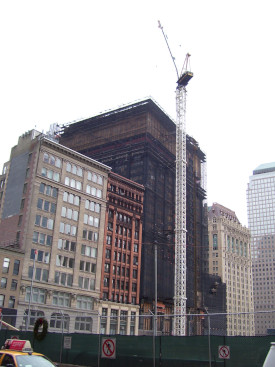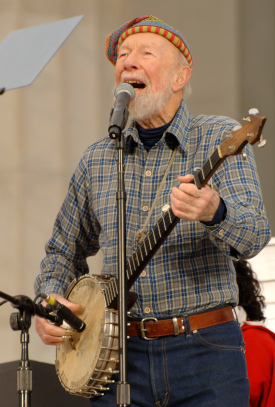Beyond the Headlines
Air Date: Week of January 26, 2024

A study in the journal JAMA Network has linked increased bone density in children to the amount of green space near their homes. (Photo: Lee Simpson, Flickr, CC BY-NC-ND 2.0)
This week, Living on Earth Contributor Peter Dykstra joins Host Aynsley O’Neill to share research that found a positive link between kids’ access to green space and their bone density. They also talk about how the practice of “deconstructing” buildings instead of demolishing them allows for reuse of many materials. And in history, they remember Pete Seeger, who passed away ten years ago after a lifetime of contributions to environmental causes and, of course, folk music.
Transcript
DOERING: It’s Living on Earth, I’m Jenni Doering.
O'NEILL: And I'm Aynsley O'Neill. It's just about the time in our show where we take a look beyond the headlines with our Living on Earth contributor, Peter Dykstra. He should be joining us now from Atlanta, Georgia. Hi, Peter, what's going on out there in the world that didn't quite make it to the headlines yet?
DYKSTRA: Hi, Aynsley. Didn't quite make it to the headlines, but a couple interesting stories that may yield positive results. The first one is a study from Belgium. It was published in the journal JAMA Network Open. Three hundred children were study subjects, ages four to six in the Flanders region of Belgium. Urban, suburban, and rural areas were included. And these kids showed much greater bone density if they lived in areas where green space, natural areas, were nearby.
O'NEILL: All right, well, green space areas sound pretty good to me. But what does the increased bone density mean for the kids?
DYKSTRA: It means a lot. It accelerates growth and the development of those kids' bodies as they move toward adulthood. But it also means a lot further down the road. Bone density as we age is a very important factor in preventing problems like osteoporosis. This Belgian study says that kids have a much lower risk of that low bone density, and their development can be much stronger at a younger age.
O'NEILL: All right, well, we'll add that to the list of great reasons to have green spaces near your home. What else do you have for us, Peter?

Deconstruction is the process of dismantling a building so that its materials can be reused. Here, the Deutsche Bank building in New York City underwent deconstruction in January 2008. (Photo: ProhibitOnions, Wikimedia Commons, CC BY-SA 3.0)
DYKSTRA: Another one that's an experiment that may already be paying off benefits in US cities like Portland, Oregon and San Antonio. Those cities are working to keep building materials out of landfills. Deconstruction is the name for it. We tend to look at buildings as something that we put up and when their useful lives end, we simply throw them away at a demolition site. 150 million tons of debris makes it to landfills and dumps across the US. Globally, the problem is much bigger than that.
O'NEILL: But so what is deconstruction, Peter? Is it just to save us the difficulty of trotting a wrecking ball out there?
DYKSTRA: It could be as simple as reusing wood from older buildings in order to build anything from flooring to a mantelpiece for a fireplace, but it could also involve grinding down old concrete and turning it into newer concrete. Concrete is essentially sand and glue. So when you think about it, it's not that hard to recycle and reuse again the basic elements of concrete.
O’NEILL: Reducing the new and reusing the old, that's a good step towards sustainability when the world is only getting more urbanized. And now Peter, I would like you to take me back into history and tell us what went on there.

Pete Seeger died in 2014, leaving behind a musical legacy as well as a history of environmental activism. (Photo: Donna Lou Morgan, U.S. Navy, Wikimedia Commons, public domain)
DYKSTRA: January 27, 2014, only 10 years ago, the beloved musician and activist Pete Seeger passed away at age 94. Seeger was blacklisted during the McCarthy era in the Cold War, and later he was voted into the Rock and Roll Hall of Fame, a pretty unique honor for a folk singer. He steered much of his good-natured zeal toward cleaning up the Hudson River. He launched the sloop, "Clearwater" as an educational and political floating symbol. Then he was instrumental in founding the first "Riverkeeper" on the Hudson. There are now hundreds of "Riverkeeper, "Baykeeper," "Soundkeeper," "Harborkeepers" throughout the world. Seeger helped start the first. His life and legacy go beyond the music, and all the way toward cleaning up one of the world's great rivers.
O'NEILL: Yeah, and I know he spoke about his environmental activism with our executive producer, Steve Curwood, back in 1998. We'll always remember Pete Seeger fondly here at Living on Earth.
DYKSTRA: We will indeed.
O'NEILL: All right, Peter. Thank you for bringing us these stories, as always. Peter Dykstra is a Living on Earth contributor, and we will talk to you again really soon.
DYKSTRA: Ok, Aynsley. Thanks a lot. Talk to you soon.
O'NEILL: And there's more on these stories, including a link to that afternoon with Pete Seeger, on the Living on Earth website. That's loe.org.
Links
The Guardian | “Children Living Near Green Spaces ‘Have Stronger Bones’”
Read the JAMA Network article here
Grist | “To Keep Building Materials Out of Landfills, Cities Are Embracing ‘Deconstruction’”
Living on Earth wants to hear from you!
Living on Earth
62 Calef Highway, Suite 212
Lee, NH 03861
Telephone: 617-287-4121
E-mail: comments@loe.org
Newsletter [Click here]
Donate to Living on Earth!
Living on Earth is an independent media program and relies entirely on contributions from listeners and institutions supporting public service. Please donate now to preserve an independent environmental voice.
NewsletterLiving on Earth offers a weekly delivery of the show's rundown to your mailbox. Sign up for our newsletter today!
 Sailors For The Sea: Be the change you want to sea.
Sailors For The Sea: Be the change you want to sea.
 The Grantham Foundation for the Protection of the Environment: Committed to protecting and improving the health of the global environment.
The Grantham Foundation for the Protection of the Environment: Committed to protecting and improving the health of the global environment.
 Contribute to Living on Earth and receive, as our gift to you, an archival print of one of Mark Seth Lender's extraordinary wildlife photographs. Follow the link to see Mark's current collection of photographs.
Contribute to Living on Earth and receive, as our gift to you, an archival print of one of Mark Seth Lender's extraordinary wildlife photographs. Follow the link to see Mark's current collection of photographs.
 Buy a signed copy of Mark Seth Lender's book Smeagull the Seagull & support Living on Earth
Buy a signed copy of Mark Seth Lender's book Smeagull the Seagull & support Living on Earth

